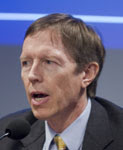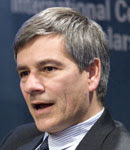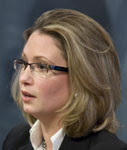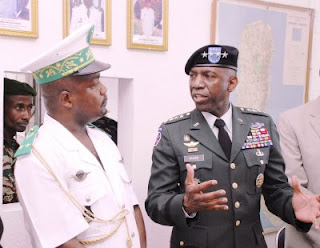-
East Africa PHE Network: Translating Strong Results Into Informed Policies
›February 24, 2009 // By Rachel Weisshaar“The road to inaction is paved with research reports,” said Marya Khan, our Population Reference Bureau facilitator, opening today’s East Africa Population-Health-Environment (PHE) Network workshop on bridging the research-to-policy gap.
At the Environmental Change and Security Program, we know all too well that even the best program or most dramatic research findings don’t stand a chance of being implemented unless they are communicated to policymakers in succinct, persuasive formats. Yet researchers often neglect to convey their results to decision makers and donors, assuming they won’t be interested or won’t appreciate their methodologies, explained Khan. Furthermore, researchers are often hesitant to draw out the policy implications of their findings, believing this is policymakers’ responsibility, while policymakers tend to think this is researchers’ duty—so these critical implications are often never explored.
Today’s sessions aimed to empower the PHE working groups from Rwanda, Uganda, Ethiopia, and Kenya to develop their own strategies to bridge the research-to-policy gap. The groups brainstormed policy communications objectives they wished to achieve—such as officially launching their country PHE network—as well as concrete outcomes that would contribute to accomplishing those objectives—such as convincing representatives from various national government ministries to join their network.
Rachel Weisshaar is attending the meeting of the East Africa PHE Network in Kigali, Rwanda. She will be posting daily updates on the New Security Beat throughout the week (see yesterday’s post).
Photo: Members of the Kenya PHE Working Group discuss communications strategies. Courtesy of Rachel Weisshaar. -
East Africa Population-Health-Environment Conference Kicks Off in Kigali
›February 23, 2009 // By Rachel Weisshaar Rwandan Minister of Natural Resources Stanislas Kamanzi officially launched the meeting of the East Africa PHE Network this morning, stating that Rwanda’s highest-in-Africa population density of 365 people per square kilometer—which he argued leads to environmental degradation and poor human health in both rural and urban areas—compels an integrated approach to development. Kamanzi said that Rwanda’s National Environment Policy and national development plan, Vision 2020, both recognize population-health-environment (PHE) links, and he expressed Rwanda’s commitment to implementing the recommendations of the First Inter-ministerial Conference on Health and Environment in Africa, which was co-hosted by the World Health Programme and the UN Environment Programme in Gabon in August 2008.
Rwandan Minister of Natural Resources Stanislas Kamanzi officially launched the meeting of the East Africa PHE Network this morning, stating that Rwanda’s highest-in-Africa population density of 365 people per square kilometer—which he argued leads to environmental degradation and poor human health in both rural and urban areas—compels an integrated approach to development. Kamanzi said that Rwanda’s National Environment Policy and national development plan, Vision 2020, both recognize population-health-environment (PHE) links, and he expressed Rwanda’s commitment to implementing the recommendations of the First Inter-ministerial Conference on Health and Environment in Africa, which was co-hosted by the World Health Programme and the UN Environment Programme in Gabon in August 2008. -
Developed World’s Dominance Declines with Age, Say Demographers
›February 5, 2009 // By Will Rogers “The whole world is aging, and the developed countries are leading the way,” said Neil Howe of the Center for Strategic and International Studies (CSIS) at a January 27, 2009, Wilson Center discussion of his latest report, The Graying of the Great Powers: Demography and Geopolitics in the 21st Century. Demography is as close as social science comes to predicting the future, Howe explained, presenting the geopolitical consequences of demographic trends over the next 50 years. Howe and co-author Richard Jackson, also of CSIS, were joined by Jennifer Sciubba of Rhodes College, who urged them and other demographers to explore how population trends interact with additional variables, such as environmental degradation, economic recession, and conflict.
“The whole world is aging, and the developed countries are leading the way,” said Neil Howe of the Center for Strategic and International Studies (CSIS) at a January 27, 2009, Wilson Center discussion of his latest report, The Graying of the Great Powers: Demography and Geopolitics in the 21st Century. Demography is as close as social science comes to predicting the future, Howe explained, presenting the geopolitical consequences of demographic trends over the next 50 years. Howe and co-author Richard Jackson, also of CSIS, were joined by Jennifer Sciubba of Rhodes College, who urged them and other demographers to explore how population trends interact with additional variables, such as environmental degradation, economic recession, and conflict.
Danger: Demographic Decline Approaching
“Populations in most developed countries will not only age, but stagnate or decline,” due to falling fertility and rising longevity, said Howe. Without “sizable immigration,” he warned, the populations of countries like the United States, France, Great Britain, Canada, Germany, and Japan will decline. As developed countries’ populations shrink, they will lose military might, savings and investment, entrepreneurship, and cultural influence. “Voltaire once said that God is on the side of biggest battalions,” Howe reminded the audience.
Developing Toward Greater Peace Jackson explained that the developing world is in the midst of the “demographic transition”—the drops in mortality and fertility that generally accompany economic and social development. Since 1970, the developing world’s overall fertility rate has declined from 5.1 to 2.9 children per woman, and its overall population growth rate has dropped from 2.2 percent to 1.3 percent per year, according to Jackson. Additionally, the median age has risen from 20 to 26 years old, “a cause for hope and optimism about the future,” Jackson argued, as countries with more balanced population age structures tend to be more democratic, prosperous, and peaceful than countries with extremely young ones.
Jackson explained that the developing world is in the midst of the “demographic transition”—the drops in mortality and fertility that generally accompany economic and social development. Since 1970, the developing world’s overall fertility rate has declined from 5.1 to 2.9 children per woman, and its overall population growth rate has dropped from 2.2 percent to 1.3 percent per year, according to Jackson. Additionally, the median age has risen from 20 to 26 years old, “a cause for hope and optimism about the future,” Jackson argued, as countries with more balanced population age structures tend to be more democratic, prosperous, and peaceful than countries with extremely young ones.
But despite the long-term possibility of a world transitioning toward greater peace and prosperity, the developing world will still experience near-term shocks. The timing and pace of the demographic transition varies widely by country and region, with some countries transitioning too fast or too far, said Jackson. These trends could push developing countries toward social collapse by acting “as a kind of multiplier on all the stresses of development,” explained Jackson—for instance, causing China “to lurch even more toward neo-authoritarianism.”
Crisis of the 2020s
Global demographic trends will converge in the 2020s to make that decade “very challenging,” said Howe. The developed world will undergo hyper-aging, population decline, and flattening GDP growth, along with rising pension and health care costs, Jackson noted. The Muslim world will experience a decade of temporary youth bulges, as the large generation that was born between 1990 and 2000 has children. The populations of Russia and Eastern Europe will implode, and Russia’s geopolitical strength and influence will wane. Meanwhile, China will experience a decade of “premature aging”; due to its one-child policy, it will become “gray” before it achieves the per capita GDP of most aging countries.
Demography and Public Policy Sciubba praised the report’s comprehensive, policy-friendly approach to demography, but urged the authors to remain true to the nuances of their topic, even in their conclusions and recommendations. “Policymakers like to know what we don’t know and what we do know. And with population aging and national security, often there’s a lot more of what we don’t know than what we do know,” she said. “Going into the future, we need more of an emphasis on places where policymakers can make a difference,” said Sciubba. “Opportunities matter just as much as challenges.”
Sciubba praised the report’s comprehensive, policy-friendly approach to demography, but urged the authors to remain true to the nuances of their topic, even in their conclusions and recommendations. “Policymakers like to know what we don’t know and what we do know. And with population aging and national security, often there’s a lot more of what we don’t know than what we do know,” she said. “Going into the future, we need more of an emphasis on places where policymakers can make a difference,” said Sciubba. “Opportunities matter just as much as challenges.”Photos: Neil Howe, Richard Jackson, and Jennifer Dabbs Sciubba. Courtesy of Dave Hawxhurst and the Wilson Center.
-
VIDEO: Jim Jarvie on How Humanitarian Groups Are Responding to Climate Change
›February 5, 2009 // By Wilson Center Staff“We recognize that in dealing with climate change, what we do is modest….But unless we get the message out and find partners who can really take it to large scale, our efforts aren’t futile, but they’re of little value over the next 30 to 50 years, which is indeed the time frame we ought to be thinking on,” says Jim Jarvie in this short expert analysis from the Environmental Change and Security Program. Jarvie, director of climate change, environment, and natural resources at Mercy Corps, discusses why humanitarian development organizations must respond to new climate challenges. -
Head of AFRICOM Discusses Civilian-Military Cooperation
›January 28, 2009 // By Rachel Weisshaar Critics have warned that the new unified U.S. Africa Command (AFRICOM) could threaten the sovereignty of African nations and encroach on the portfolios of other U.S. agencies like the U.S. Agency for International Development (USAID). But in an interview with USAID newsletter FrontLines, General William E. “Kip” Ward, head of AFRICOM, went out of his way to dispel these fears. Some of the most interesting parts of the interview:
Critics have warned that the new unified U.S. Africa Command (AFRICOM) could threaten the sovereignty of African nations and encroach on the portfolios of other U.S. agencies like the U.S. Agency for International Development (USAID). But in an interview with USAID newsletter FrontLines, General William E. “Kip” Ward, head of AFRICOM, went out of his way to dispel these fears. Some of the most interesting parts of the interview:
On AFRICOM’s humanitarian efforts:
“We know that our piece is only a very small part of the totality of humanitarian assistance that’s being performed by USAID and other agencies. We would not look to take those roles over.”
On civilian-military cooperation:
“We are learning to understand one another better and truly, as [USAID] Administrator [Henrietta] Fore and [Defense] Secretary [Robert] Gates said, we are seeing with greater clarity the importance of all these efforts working as cohesively together as they can. Security and development go hand-in-hand to produce stability that we all seek.”
On coordinating with USAID and host countries:
“We would get involved where those development projects complemented the work being done by developmental agencies, USAID, in very close coordination with the country team, the ambassador, and representatives from USAID that are there on the ground. We want to ensure that we don’t do things that conflict with the work being done by others. This might include a school being built so we can complement each other’s efforts. Or, at the request of a country, we might conduct an exercise and we may need to build a road to get to a training area. And if building the road in one place or another could help the population, then we would look to work with the country team and the ambassador so it provides benefits to the population.”
Photo: Comoran Defense Chief of Staff Salimou Mohamed Amiri (left) talks with General William E. Ward, commander of U.S. Africa Command (right), on January 21, 2009. Ward met with Comoran government officials as part of his first official visit to the island nation. Courtesy of by Kenneth Fidler, U.S. Africa Command. -
Reading Radar– A Weekly Roundup
›January 23, 2009 // By Wilson Center Staff“As long as we continue to subsidize Gaza’s extreme demographic armament, young Palestinians will likely continue killing their brothers or neighbors. And yet, despite claiming that it wants to bring peace to the region, the West continues to make the population explosion in Gaza worse every year. By generously supporting UNRWA’s budget, the West assists a rate of population increase that is 10 times higher than in their own countries,” argues the University of Bremen’s Gunnar Heinsohn in the Wall Street Journal.
In an article for the Huffington Post, Water Advocates’ John Sauer argues that we should group together waterborne diseases like diarrhea, typhoid, and cholera under the name “No-Plumbing Disease,” to help water and sanitation get the attention they deserve.
It takes a strong editor to push for stories on development issues like poverty and public health, but there is often surprisingly high interest in these stories, writes Richard Kavuma for the Guardian.Yale Environment 360 sums up President Obama’s statements on the environment in his inaugural address.
The Democratic Republic of the Congo has cancelled nearly 60 percent of its logging contracts in an attempt to end corrupt and environmentally destructive logging, report the BBC and Reuters.
“Could the crises of food, fuel and finance that we experienced in 2008 simply be three canaries in the coalmine? What if these are just the early-warning signals that our current economic system is not sustainable at a much deeper level?” asks Dominic Waughray, head of environmental initiatives at the World Economic Forum.
“A flurry of scientific field work and environmental reports have linked the spread of oil palm plantations in Indonesia to the decimation of rain forests, increased conflict between logging and oil palm interests and rural and indigenous people, and massive CO2 emissions through logging, burning, and the draining of carbon-rich peat lands,” writes Tom Knudson on Yale Environment 360.
A nickel mine in Madagascar is likely to harm biodiversity in one of the world’s most biologically unique places, reports mongabay.com.
“It is high time that India and Pakistan consider the primacy of ecological cooperation as a means of lasting conflict resolution,” argues Saleem Ali in Pakistan’s Daily Times. -
Obama Mentions International Development in Inaugural Address; NGOs Rush to Respond
›January 23, 2009 // By Rachel WeisshaarWere you one of the millions—or billions—who tuned in to watch President Barack Obama’s inauguration on Tuesday? If so, and you also happen to be one of several thousand New Security Beat readers, your ears probably perked up at this paragraph in his inaugural address:“To the people of poor nations, we pledge to work alongside you to make your farms flourish and let clean waters flow; to nourish starved bodies and feed hungry minds. And to those nations like ours that enjoy relative plenty, we say we can no longer afford indifference to the suffering outside our borders; nor can we consume the world’s resources without regard to effect. For the world has changed, and we must change with it.”
Development practitioners and advocates are tickled pink that President Obama saw fit to mention their issues in such a prominent forum. They’re not resting on their laurels, though: ONE launched an e-mail campaign asking supporters to thank President Obama for his commitment to international development and urge him to include funding for it in his first presidential budget request.
Meanwhile, WaterAid America released a statement saying it “welcomes the mention of clean water in Obama’s speech and stands ready to support the commitment made by the new President in his first day of office. Along with other NGOs, WaterAid America has been encouraging the new administration to recognize the importance of clean water and sanitation and to take a lead to end the years of political neglect of these vital services.”
Although Obama did not mention family planning and reproductive health in his speech, population experts are also trying hard to ensure their recommendations are heard by the new administration. -
In Rio de Janeiro, an Opportunity to Break Barriers
›January 23, 2009 // By Will Rogers The city of Rio de Janeiro’s plan to erect a 650-meter long, three-meter high concrete wall between the 7,500 residents of the Dona Marta slum and the surrounding rainforest signals the government’s reluctance to address the underlying causes of environmental degradation. Although it is heralded by authorities as an “eco-barrier” that will protect the rainforest and “improve living standards and protect slum residents from the armed gangs that control many of Rio’s 600 or so slums,” the wall does not address the issues of acute poverty and lack of access to affordable housing that keep many Brazilians living in slums, harvesting resources from the rainforest.
The city of Rio de Janeiro’s plan to erect a 650-meter long, three-meter high concrete wall between the 7,500 residents of the Dona Marta slum and the surrounding rainforest signals the government’s reluctance to address the underlying causes of environmental degradation. Although it is heralded by authorities as an “eco-barrier” that will protect the rainforest and “improve living standards and protect slum residents from the armed gangs that control many of Rio’s 600 or so slums,” the wall does not address the issues of acute poverty and lack of access to affordable housing that keep many Brazilians living in slums, harvesting resources from the rainforest.
Without access to decent housing and living-wage jobs, many slum residents will continue to encroach on the hillsides, warn Brazilian environmentalists. “It is hypocrisy to talk about protecting the Atlantic rainforest without considering the issues of housing and transport to take the pressure off the forest,” said Sergio Ricardo, a leading environmental campaigner in Rio de Janeiro, in an interview with the Jornal do Brasil.
Slums have often stalled Rio’s efforts to improve its environmental report card, as slum residents tend to be focused more on daily survival than on the environmental consequences of their actions. But slums do not have to be a thorn in the side of the government’s eco-friendly image. In fact, Rio’s previous attempts to reverse deforestation through grassroots reforestation projects have been extremely successful.
According to a 2005 article in the San Francisco Chronicle, municipal reforestation projects around Rio employed several hundred slum residents to plant millions of trees surrounding their communities. The projects “resulted in the return of dozens of species of birds, monkeys and other animals—many not seen in decades,” as well as cooler air temperatures, writes William Bennett. At the same time, the municipal projects became a source of steady work for residents. “Before this job, I worked as a day laborer; one day I would have work—the next day nothing,” said Carlos Alberto Ribeiro, a reforestation worker who earned about $200 a month planting trees. By 2005, community reforestation projects had employed 914 slum residents in 93 projects that had restored a total of 4,500 acres of native-species trees to the region.
Rather than segregating slum residents from the rest of the city in what some critics have called “social apartheid,” perhaps Rio should scale up community forestry projects, employing greater numbers of slum residents to improve the health of the Atlantic rainforest. While the government still has far to go in providing affordable housing, a steady wage could help residents secure access to adequate housing and reduce pressure on the region’s delicate environment.
Photo: Rocinha, one of Rio de Janeiro’s largest slums with an estimated 200,000 residents, is one of hundreds of slum neighborhoods surrounding Rio, putting extreme pressure on the region’s environment. Courtesy of flickr user andreasnilsson1976.
Showing posts from category development.



 Rwandan Minister of Natural Resources
Rwandan Minister of Natural Resources  “The whole world is aging, and the developed countries are leading the way,” said Neil Howe of the Center for Strategic and International Studies (CSIS) at a January 27, 2009,
“The whole world is aging, and the developed countries are leading the way,” said Neil Howe of the Center for Strategic and International Studies (CSIS) at a January 27, 2009,  Jackson explained that the developing world is in the midst of the “demographic transition”—the drops in mortality and fertility that generally accompany economic and social development. Since 1970, the developing world’s overall fertility rate has declined from 5.1 to 2.9 children per woman, and its overall population growth rate has dropped from 2.2 percent to 1.3 percent per year, according to Jackson. Additionally, the median age has risen from 20 to 26 years old, “a cause for hope and optimism about the future,” Jackson argued, as countries with more balanced population age structures tend to be
Jackson explained that the developing world is in the midst of the “demographic transition”—the drops in mortality and fertility that generally accompany economic and social development. Since 1970, the developing world’s overall fertility rate has declined from 5.1 to 2.9 children per woman, and its overall population growth rate has dropped from 2.2 percent to 1.3 percent per year, according to Jackson. Additionally, the median age has risen from 20 to 26 years old, “a cause for hope and optimism about the future,” Jackson argued, as countries with more balanced population age structures tend to be  Sciubba praised the report’s comprehensive, policy-friendly approach to demography, but urged the authors to remain true to the nuances of their topic, even in their conclusions and recommendations. “Policymakers like to know what we don’t know and what we do know. And with population aging and national security, often there’s a lot more of what we don’t know than what we do know,” she said. “Going into the future, we need more of an emphasis on places where policymakers can make a difference,” said Sciubba. “Opportunities matter just as much as challenges.”
Sciubba praised the report’s comprehensive, policy-friendly approach to demography, but urged the authors to remain true to the nuances of their topic, even in their conclusions and recommendations. “Policymakers like to know what we don’t know and what we do know. And with population aging and national security, often there’s a lot more of what we don’t know than what we do know,” she said. “Going into the future, we need more of an emphasis on places where policymakers can make a difference,” said Sciubba. “Opportunities matter just as much as challenges.” Critics have warned that the new unified U.S. Africa Command (
Critics have warned that the new unified U.S. Africa Command ( The city of Rio de Janeiro’s plan to erect a
The city of Rio de Janeiro’s plan to erect a 

